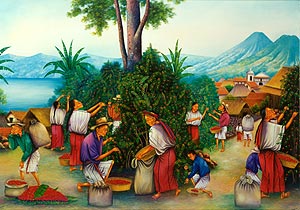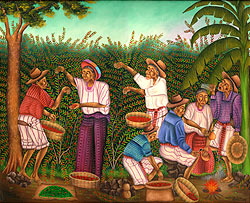|
|
|
| . | |
 |
|
| . |
|
| . | |
| . | |
 |
|
| . | |
|
LINKS TO SECTION PAGES |
|
| . | |
| If Pedro Rafael González (b.1956) was the first oil painter
in San Pedro, his age mate and kinsman Mariano González (b.1956) was not far behind. As a
child Mariano liked sports and bathing in the lake, but most of all he loved drawing. Like
Pedro Rafael, Mariano distinguished himself in drawing while in grade school, aspired
early to become a painter, apprenticed himself to José Antonio in Guatemala City, won
prizes in a series of art expositions and found his first market in El Sombol. Unlike Pedro Rafael, who states with pride that he never was anybody's pupil, Mariano received instruction from two of the most important painters in Santiago Atitlán, Manuel Reanda and Miguel Chavez. The latter recalls that Mariano exhibited an insatiable interest in learning how the instructor painted. "How do you paint the market at night?" "How do you paint the light from the candles?" Mariano had been concentrating on small detailed paintings but Manuel Reanda persuaded him to work on large canvases, and this change pushed Mariano in to his particular area of strength. He is master of the large detailed painting which he executes with confidence and speed, often in a week or two. Many of his best works measure three feet by four. Once he is satisfied with the sketch on his canvas, Mariano applies the paint in an order somewhat different from that of Pedro Rafael. After painting the mountains and other background elements, for example, he will color the buildings, trees and other aspects of the mid-ground. At this stage, the picture may look finished except for conspicuous white areas reserved for the human figures. He will then paint the faces, arms and bare feet of all the people in the picture before painting the colorful native clothes they wear. Sometimes he will reverse the order, painting the clothes before the faces and limbs. If the scene is one of picking coffee, a favorite theme among painters and the public, he will add the red berries last, either on the branches of coffee bushes or piled high in a huge basket. a recent innovation on Mariano's part is to enhance the decorative effect of the painting by giving the berries a three-dimensional appearance, making the viewer want to touch the bright globular forms. In a manner somewhat reminiscent of Rubens or Titian, Mariano sometimes converts his studio into a workshop. He has taught his wife to paint and directs her, along with any apprentices that may be on hand, to paint the thousands of raised coffee berries or the less important features of a picture's background. |
|
| . | |
 |
|
| . | |
| Mariano taught his younger brother Matías (b. 1959), three
years his junior, how to paint. Like Mariano, Matías abandoned teacher training in
mid-course to become an artist. Like Pedro Rafael and Mariano, Matías sold his first
paintings to El Sombol. While Matías' style bears resemblances to Mariano's, his paintings
seem less serious, partly because his depiction of people is more naive. Whether by design
or not, Matías sometimes makes mistakes, such as harvesting bananas from a palm tree, that
have the effect of imparting charm and a touch of humor to his paintings. More than the
productions of other San Pedro artists, the paintings of Matías, especially those of the
jungle and the fields, recall the paintings of Henri Rousseau. It is not surprising that Mariano and Matías González should be painters. Their uncle, Rafael González y González, was the first person from San Pedro La Laguna to become a painter. Their father, who started out painting masks, made his living painting churches, municipal buildings, signs and grave stones. As a child Matías assisted his father in painting buildings, signs, and grave stones. Matías started off handing him the brushes and paint, in this way gradually learning about painting. Beyond their talent and hard work, the artistic success of Mariano and Matías owes a lot to their older brother Benjamin's successful promotion of their art. The bothers Mariano and Matías González Chavajay, together with their cousin Pedro Rafael González Chavajay, are the most distinguished painters in San Pedro La Laguna. |
|
| . | |
| LINKS TO SECTION PAGES |
|
|
To contact us write: Arte Maya Tz'utuhil, P.O. Box 40391, San
Francisco, CA 94140. Telephone: (415) 282-7654.
Email me at
All paintings and photographs Copyright © 1988–2015 Arte Maya Tz'utuhil |
|